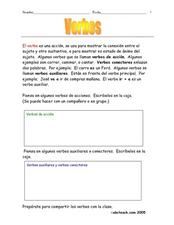Curated OER
Gustar
Me gusta, te gusta, y le gusta are different forms of the reflexive verb: gustar. Young scholars can practice using gustar in this PowerPoint by choosing the correct option to fill in the blank of twenty-two sentences. Tip: Assign...
Curated OER
Verbs in Spanish
In this Spanish verbs worksheet, students conjugate Spanish phrases with verbs back to English. Students complete 28 problems total.
Curated OER
El Tiempo Pretérito-Más Información
Here's a great reference guide on the preterite tense! The spelling changes with infinitive endings of -car, -gar, and -zar are covered, and the charts provided are easy to understand.
Curated OER
Using Saber and Conocer
What is the difference between saber and conocer? Language learners sometimes have difficulty with these words because of their similar meaning. Clear up confusion with the information and presentation included here. The website and...
Curated OER
La canción del pretérito
La cucaracha, la cucaracha! Use this catchy tune to help your beginning Spanish learners remember the preterite tense. Distribute this sheet, so everyone can sing along!
Curated OER
Weather and Plans
If the weather is nice this weekend, what are your plans? Review weather vocabulary when practicing the future tense with this four-page packet. Learners will identify the correct future tense for several sentences provided and write...
Curated OER
Contractions
Teach your class about contractions in Spanish. This resource provides explanations, examples, and a short practice section. Your learners will understand the two Spanish contractions in no time!
Curated OER
Verbos: Verbos de acción y verbos conectores
Have your Spanish language learners brainstorm a list of action verbs and another list of auxiliary/ linking verbs. Depending on your class, you might want to provide a list of verbs for them to organize into these categories.
Curated OER
Preterite vs. Imperfect #1
Consider using this half-sheet grammar focus as a pop quiz or bell-ringer to get the day started. Today's focus is using the imperfect tense and Spanish preterites. Your learners read the paragraph provided and use the verbs in...
Curated OER
Preterite vs. Imperfect #10
Compile a packet of practice worksheets for your beginning Spanish speakers learning about expressing actions in the past tense and using preterite verbs. Simply search more worksheets for preterite and imperfect tenses to add resources!
Curated OER
Preterite vs. Imperfect #4
This bell-ringer is a great way to start the day after introducing the imperfect tense to your intermediate Spanish speakers! Your pupil reads the short paragraph and uses the words in parentheses to complete the sentences. There are 15...
Curated OER
Present Perfect 1
Your intermediate and advanced Spanish speakers review the present perfect. Several example sentences are given, and learners have to choose which conjugated verb fits in each sentence correctly.
Curated OER
Worksheet-Subjunctive vs. Infinitive
How do you teach the subjunctive? This sheet, intended for learners who already know what the subjunctive is and how it is formed, builds learners' understanding. First they'll simply change the verb from the infinitive to the...
Curated OER
Formal Commands (Mandatos)
How do you give a formal command in Spanish? Study the charts provided and complete the practice below. This resource is easy to follow and gives learners organized information for easy recall.
Curated OER
Irregular Formal Commands
After learning the regular formal commands for the Spanish language, your linguists should learn the irregular formal commands. First, they complete the chart with select irregular verbs like ir, caber, and caer. Then, in the second...
Curated OER
Irregular Formal Commands (Mandatos)
How do you form irregular formal commands in Spanish? Now that your class has learned how to form the Ud. and Uds. commands, review some of the irregular formal commands. First encourage learners to study the charts at the top of the...
Curated OER
Preterite vs. Imperfect #6
Now that your class has mastered the preterite tense, introduce the imperfect tense. Give them a verb conjugation chart to help them complete this short exercise. There are -ar, -ir, and common verbs to conjugate.
Curated OER
Verbos: -ar
Use this short exercise as a bell-ringer or exit card to give your class a quick assessment. Are they learning how to conjugate verbs? Which ones might you need to reteach? Only 11 -ar verbs are listed.
Curated OER
Past Participles
Consider this online resource that includes accurate information about past participles for a reference material for your Spanish language, or as a source of inspiration for your own lesson. Beginning with a definition of past...
Curated OER
Preterite Forms of -AR, -ER, -IR Verbs
Students explore how to form the preterite forms of regular -AR, -ER, and -IR verbs. They complete a variety of written task in which they write the correct preterite forms of the verbs. Students complete a worksheet finding the correct...
Curated OER
Future Actions
How do you conjugate a reflexive verb? This plan suggests reading a children's book to your intermediate Spanish speakers. Follow the reading with a PowerPoint slide show that presents reflexive verbs, a sentence using the verb, and a...
Curated OER
Subjunctive vs. Indicative (present only) #1
How do you use the subjunctive? Review the difficult tense with your intermediate Spanish language learners, and then give them this practice opportunity! There are only 10 fill in the blank questions, and your scholar inputs the correct...
Curated OER
Preterite vs. Imperfect #3
Hm, to use the preterite or the imperfect? That is the question with this short practice activity! Use it as a bell-ringer or a short homework assignment. Learners simply read the paragraph and conjugate the verbs in parentheses to...
Curated OER
Question Words 1
Check out this PowerPoint from a series of presentations regarding Spanish question verbs. This first version provides viewers with an explanation of question words, as well as example sentences to practice using them. Note: Find more...

























